Let me tell you about the best Chicken Pochero recipe that changed my lunch breaks forever. Back when I was working in Rockwell Business Center in Ortigas, my officemate, Charm, would bring this amazing pocherong manok every Wednesday, selling it for ₱80 per container.
The moment that rich tomato broth with tender chicken and perfectly cooked saba would hit our pantry, everyone would rush to be first in line. I finally convinced her to teach me this recipe, and let me tell you, it's pure Filipino comfort in a pot.
She learned it from her Lola, who used to cook this for their family in Batangas, adding chorizo de Bilbao for that extra smoky flavor that makes you want to eat three cups of rice (diet starts tomorrow, promise!).
Think of this as your upgraded chicken soup, but with all the Filipino flavors we grew up loving. It's perfect for those rainy days when you want something warm and filling, or when you're trying to impress your visiting titas without breaking the bank (It's way cheaper than the beef version).
I've been cooking this chicken pochero recipe for five years now, and it never fails to bring back memories of our noisy office lunch breaks and Charm's plastic containers that always had a waiting list.
Jump to:
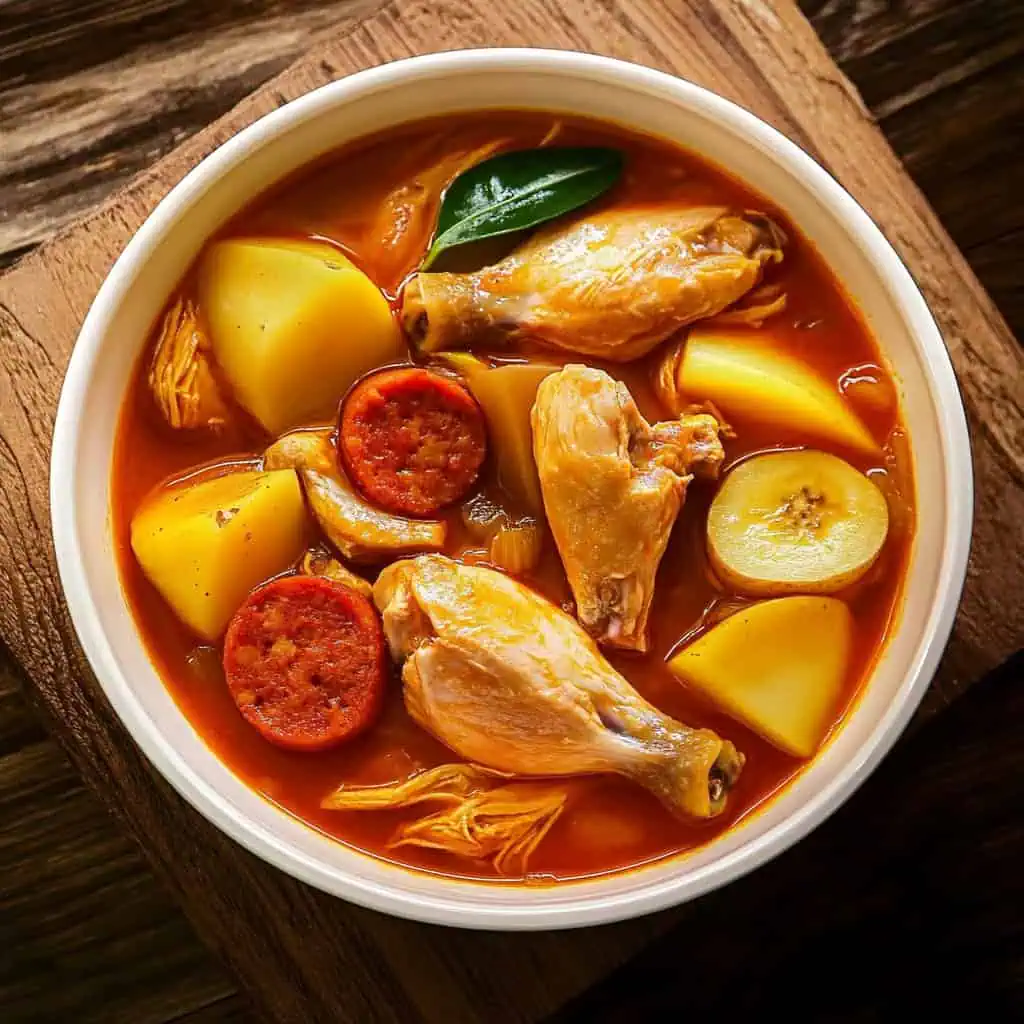
Why You'll Love This Recipe
- One-pot complete meal featuring protein, vegetables, and starches
- Budget-friendly alternative to traditional beef pochero
- Make-ahead friendly - tastes even better the next day
- Perfect balance of Spanish and Filipino flavors
- Customizable to your family's preferences
- Ideal for Sunday family gatherings (salu-salo)
- Freezer-friendly for meal prep
Ingredients
This chicken pochero carefully balances traditional Filipino and Spanish influences. Bone-in chicken provides rich flavor while staying tender in the long simmer. Saba bananas add a signature sweetness that complements the savory elements.
Chorizo de Bilbao contributes a smoky depth that elevates the tomato broth, while garbanzo beans offer protein and texture. The variety of vegetables (cabbage, pechay, carrots, green beans) makes this a complete one-pot meal, each adding distinctive textures and nutrients. Fish sauce introduces that unmistakable Filipino umami that ties everything together.
These ingredients weren't chosen randomly - they represent generations of home cooks finding the perfect balance between hearty satisfaction and complex flavor in an affordable, accessible dish.
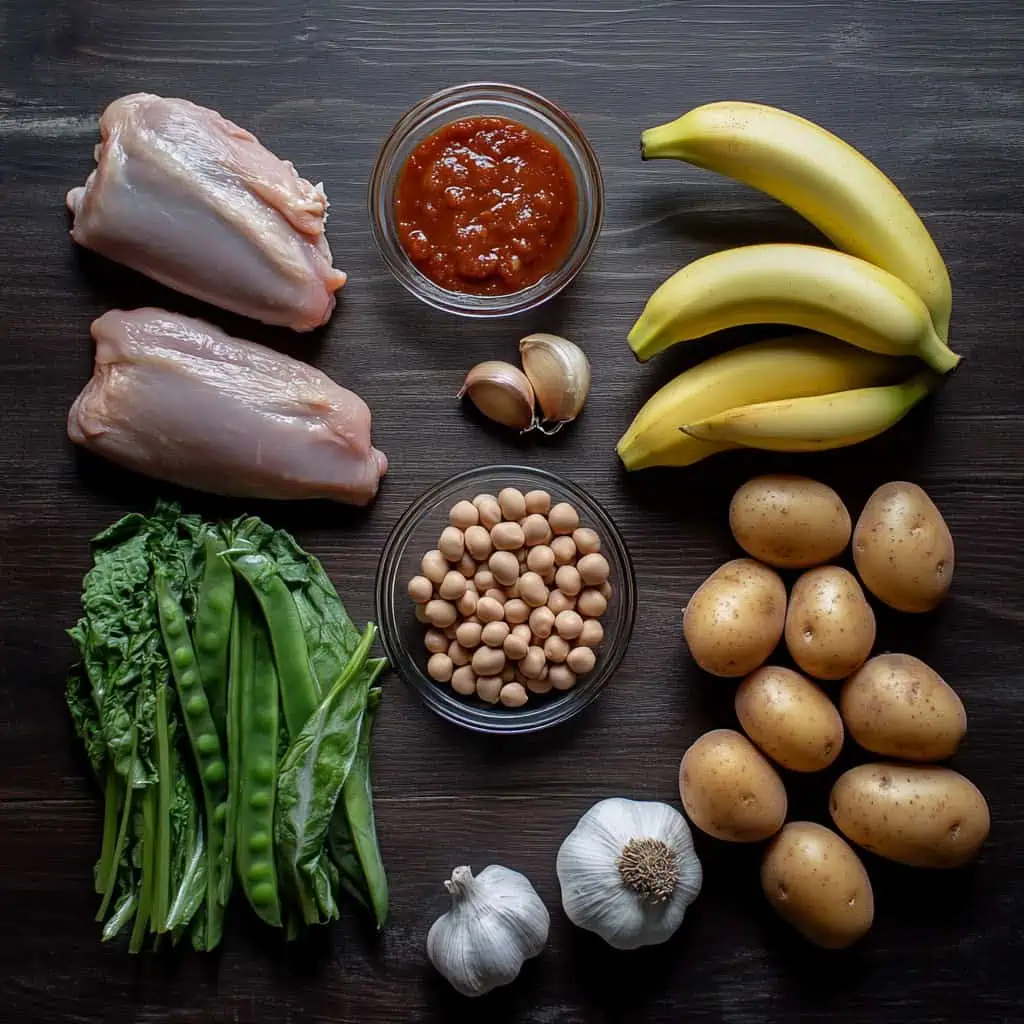
- 3 pounds chicken pieces - preferably bone-in
- ¼ cup cooking oil
- 1 large onion, thinly sliced
- 4 cloves garlic, minced
- 1 cup tomato sauce
- 3 cups chicken broth or water
- 2 tablespoons fish sauce
- 3 ripe saba bananas, halved
- 2 medium potatoes, quartered
- 2 chorizo de Bilbao, sliced diagonally
- 1 cup garbanzo beans
- 12 green beans, trimmed
- ½ Chinese cabbage, cut into wedges
- 1 bunch pechay, separated leaves
- 2 medium carrots, chunked
- Salt and pepper to taste
Equipment
- Large Dutch oven or heavy pot - For even heat distribution and preventing burning
- Sharp chef's knife - For precise cutting of vegetables and meat
- Cutting board - Preferably separate ones for meat and vegetables
- Wooden spoon or heat-resistant spatula - For stirring without scratching your pot
- Measuring cups and spoons - For accurate ingredient portions
- Meat thermometer - To ensure chicken reaches safe internal temperature (165°F/75°C)
- Slotted spoon - For removing fried bananas and potatoes
- Paper towels - For draining excess oil from fried ingredients
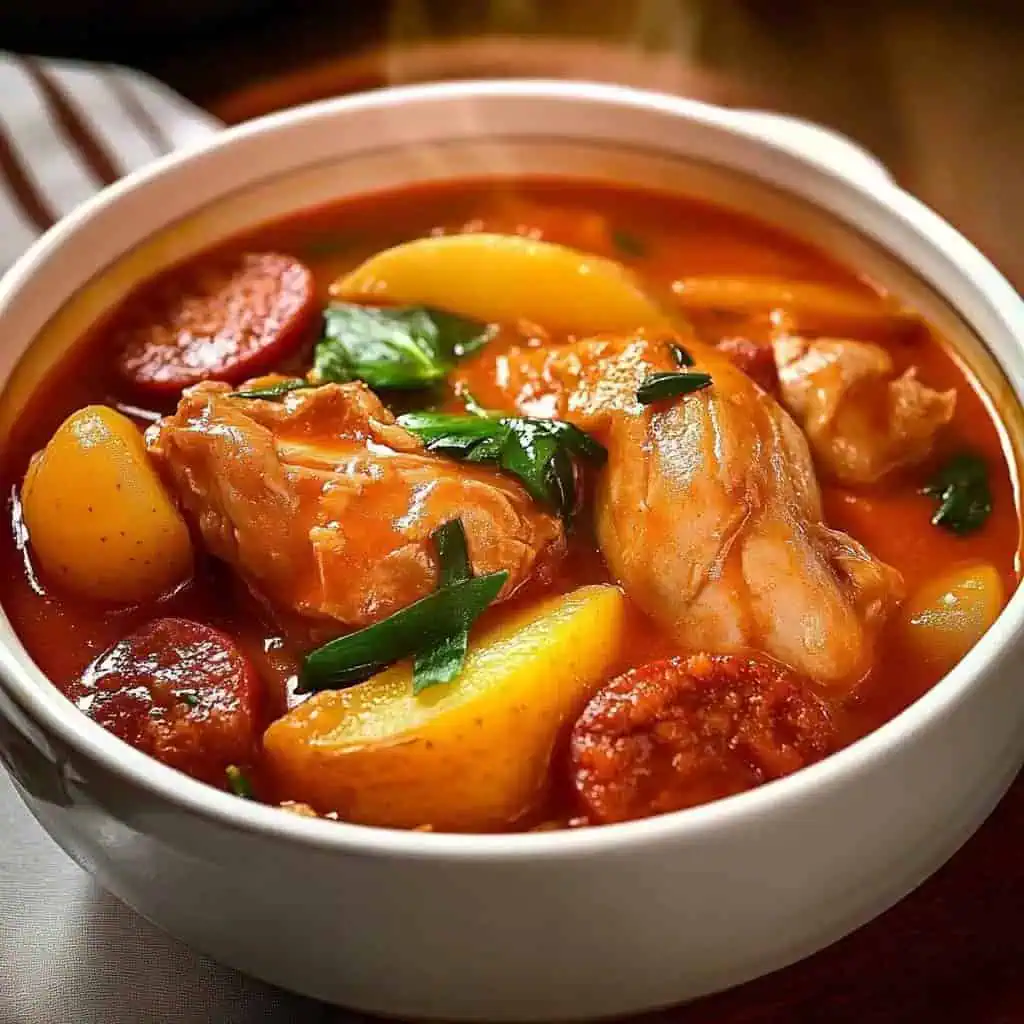
How to Make
- Begin by cleaning all your chicken pieces well and patting them dry with paper towels. Gather and prepare all your ingredients before starting. Slice your onions thinly, mince the garlic, and cut all vegetables into uniform 2-inch pieces.
- Heat your cooking oil in a large pot over medium heat (180°C/350°F). Once hot, fry your saba bananas until they turn golden brown, about 2-3 minutes per side. Remove the bananas and set aside. In the same oil, fry your potato chunks until lightly browned, about 5 minutes, then set aside.
- Lower the heat to medium (160°C/320°F) and in the same pot, sauté your minced garlic until fragrant, about 30 seconds. Add your sliced onions and cook until they become translucent, about 2-3 minutes.
- Add your chicken pieces to the pot and brown them slightly on all sides, about 3-4 minutes per side. Pour in your fish sauce and let it cook for 2 minutes.
- Add your tomato sauce and chicken broth to the pot. Bring everything to a boil, then reduce the heat to low (140°C/285°F). Cover the pot and let it simmer until the chicken becomes tender and reaches an internal temperature of 75°C/165°F, about 20-25 minutes.
- Once the chicken is tender, add your potatoes and chorizo to the pot. Cook for 5 minutes, then add your garbanzo beans and carrots. Cook for another 3 minutes.
- Return your fried saba bananas to the pot. Add your cabbage and green beans, cooking for 2 minutes. Finally, add your pechay and cook just until the leaves wilt, about 1 minute.
- Taste your stew and season with salt and pepper as needed. Let everything rest for 10 minutes before serving to allow the flavors to blend together perfectly.
- Serve your pochero hot with steamed white rice. Place small dishes of fish sauce on the table for those who want to add more saltiness to their portions.

Tips from Lola's Kitchen
- Use bone-in chicken pieces for a significantly richer and more flavorful broth
- Pre-fry the bananas and potatoes separately to develop a caramelized exterior that prevents them from dissolving into the stew
- Add vegetables in stages according to their cooking time needs - root vegetables first, leafy greens last
- Let the stew rest for 15 minutes after cooking to allow flavors to fully develop and meld together
- Reserve some fresh herbs (like scallions) to sprinkle right before serving for bright flavor contrast
- Simmer uncovered during the last 10 minutes if you prefer a thicker consistency
- Use the freshest seasonal vegetables available for optimal flavor and texture
Substitutions
- Chorizo de Bilbao → Bacon, ham, or Spanish-style chorizo
- Saba bananas → Plantains (slightly less sweet) or regular bananas (cook for less time)
- Pechay → Bok choy, spinach, or any leafy greens
- Garbanzo beans → White beans, kidney beans, or lima beans
- Tomato sauce → 4 fresh tomatoes (diced) plus 1 tablespoon tomato paste
- Fish sauce → Soy sauce plus a pinch of salt (though this changes the flavor profile)
- Bone-in chicken → Boneless thighs (cook for less time) or chicken breast (be careful not to overcook)
Troubleshooting
- Broth too thin? Simmer uncovered for 10-15 minutes to reduce, or add 1 tablespoon tomato paste
- Chicken not tender enough? Return to a simmer for an additional 15 minutes before adding vegetables
- Vegetables too mushy? Add them later in the cooking process and don't overcook after adding
- Flavors seem bland? Add an additional tablespoon of fish sauce and freshly ground black pepper
- Too acidic? Add ½ teaspoon of sugar to balance the acidity from tomatoes
- Chorizo releasing too much oil? Blot with a paper towel or pre-cook chorizo separately
- Garbanzo beans still firm? They may need to be pre-cooked or soaked longer before adding
Storage & Reheating
- Refrigerate: Transfer cooled pochero to airtight containers and store in refrigerator for up to 4 days
- Freeze: Store in freezer-safe containers without leafy vegetables for up to 3 months
- Thawing: Transfer from freezer to refrigerator 24 hours before reheating
- Reheating on stovetop: Warm gently over medium-low heat, stirring occasionally, adding broth if needed
- Microwave reheating: Use 2-minute intervals at 70% power, stirring between intervals
- Food safety: Ensure internal temperature reaches 165°F (74°C) when reheating
- Flavor enhancement: Add a fresh squeeze of calamansi or lemon when reheating to brighten flavors
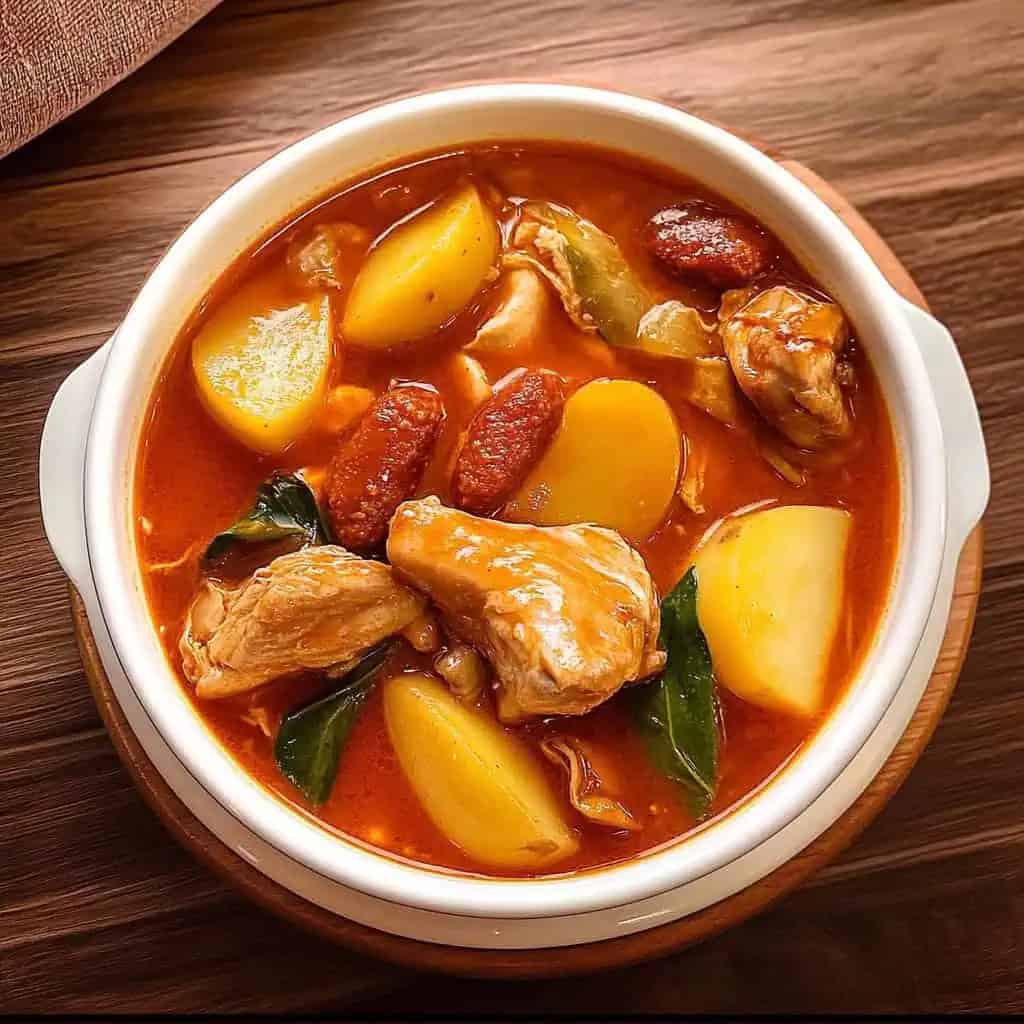
FAQ
Can I make this in a slow cooker?
Yes! Brown the chicken and sauté the aromatics first, then transfer to a slow cooker with remaining ingredients except the leafy greens. Cook on low for 6-7 hours, adding the leafy vegetables during the last 30 minutes.
Why do I need to pre-fry the bananas and potatoes?
Pre-frying creates a protective outer layer that prevents them from breaking down during simmering, maintains their distinct texture, and adds a caramelized flavor to the dish.
Can I use chicken breast instead of bone-in pieces?
Yes, but reduce the simmering time to 15 minutes to prevent the meat from drying out. Bone-in pieces provide more flavor, but boneless breasts work well for a leaner option.
How spicy is this dish?
Traditional pochero is not spicy. If you prefer heat, add 1-2 chopped bird's eye chilies during the sautéing stage or serve with chili sauce on the side.
Is pochero good for meal prep?
Absolutely! The flavors actually improve after a day in the refrigerator. Store the leafy greens separately and add them when reheating for best texture.
What makes a good pochero broth?
A balance of tomato acidity, umami from fish sauce, and richness from chicken. The longer you simmer the bone-in chicken, the more collagen is released, creating that silky mouthfeel in authentic pochero.
How can I make this dish healthier?
Use skinless chicken, reduce oil to 2 tablespoons, increase the vegetable quantity, and serve with brown rice instead of white rice.
Can I add other vegetables not in the recipe?
Absolutely! Sweet corn, chayote, calabaza squash, and sweet potatoes all work wonderfully in pochero. Add them based on their cooking time requirements.
Related
Looking for other recipes like this? Try these:
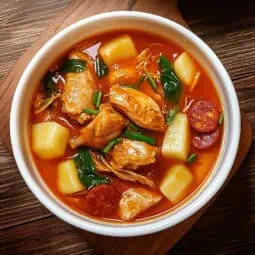
Chicken Pochero (Pocherong Manok)
Ingredients
For the Base
- 3 pounds chicken pieces manok - preferably bone-in
- ¼ cup cooking oil langis
- 1 large onion sibuyas, thinly sliced
- 4 cloves garlic bawang, minced
- 1 cup tomato sauce sarsa ng kamatis
- 3 cups chicken broth or water sabaw ng manok
- 2 tablespoons fish sauce patis
Vegetables and Add-ins
- 3 ripe saba bananas saging na saba, halved
- 2 medium potatoes patatas, quartered
- 2 chorizo de Bilbao sliced diagonally
- 1 cup garbanzo beans garbanzos
- 12 green beans sitaw, trimmed
- ½ Chinese cabbage repolyo, cut into wedges
- 1 bunch pechay separated leaves
- 2 medium carrots karot, chunked
- Salt and pepper to taste asin at paminta
Instructions
- Begin by cleaning all your chicken pieces well and patting them dry with paper towels (linisin at patuyuin ang manok). Gather and prepare all your ingredients before starting. Slice your onions thinly (hiwain ng manipis ang sibuyas), mince the garlic (dikdikin ang bawang), and cut all vegetables into uniform 2-inch pieces (hiwain ang mga gulay ng pantay-pantay, mga 2 pulgada ang haba).
- Heat your cooking oil in a large pot over medium heat (180°C/350°F). Once hot, fry your saba bananas until they turn golden brown, about 2-3 minutes per side (iprito ang saging na saba hanggang maging golden brown). Remove the bananas and set aside. In the same oil, fry your potato chunks until lightly browned (iprito ang patatas hanggang magkulay brown), about 5 minutes, then set aside.
- Lower the heat to medium (160°C/320°F) and in the same pot, sauté your minced garlic until fragrant (igisa ang bawang hanggang mabango), about 30 seconds. Add your sliced onions and cook until they become translucent (igisa ang sibuyas hanggang maging malinaw), about 2-3 minutes.
- Add your chicken pieces to the pot and brown them slightly on all sides (igisa ang manok hanggang magkulay brown), about 3-4 minutes per side. Pour in your fish sauce and let it cook for 2 minutes (ibuhos ang patis at lutuin ng 2 minuto).
- Add your tomato sauce and chicken broth to the pot (ibuhos ang sarsa ng kamatis at sabaw ng manok). Bring everything to a boil, then reduce the heat to low (140°C/285°F). Cover the pot and let it simmer until the chicken becomes tender and reaches an internal temperature of 75°C/165°F (pakuluan hanggang lumambot ang manok), about 20-25 minutes.
- Once the chicken is tender, add your potatoes and chorizo to the pot (ilagay ang patatas at chorizo). Cook for 5 minutes, then add your garbanzo beans and carrots (ilagay ang garbanzos at carrot). Cook for another 3 minutes.
- Return your fried saba bananas to the pot (ibalik ang pritong saging). Add your cabbage and green beans (ilagay ang repolyo at sitaw), cooking for 2 minutes. Finally, add your pechay and cook just until the leaves wilt (ilagay ang pechay hanggang malanta lang ang dahon), about 1 minute.
- Taste your stew and season with salt and pepper as needed (timplahan ng asin at paminta). Let everything rest for 10 minutes before serving (palamiguhin ng 10 minuto bago ihain) to allow the flavors to blend together perfectly.
- Serve your pochero hot with steamed white rice (ihain ang pochero nang mainit kasama ang kanin). Place small dishes of patis on the table for those who want to add more saltiness to their portions (maglagay ng patis sa mesa para sa gustong dagdagan ang alat).
- For storage (para sa pag-iimbak), let the pochero cool completely before transferring to an airtight container. It will keep in the refrigerator for up to 4 days. When reheating (para sa muling paginit), warm it gently over medium heat (160°C/320°F) or in the microwave, making sure the chicken reaches 75°C/165°F for food safety. Add a little water or broth if the sauce becomes too thick.
- Remember that the vegetables should maintain some crispness, this is a sign of a well-cooked pochero. The chicken should be very tender but still holding its shape (malaman pero malambot ang manok), and the bananas should be soft but not mushy (malambot ang saging pero hindi sobrang lata).
Tips from Lola's Kitchen
- Use bone-in chicken pieces for richer broth (mas malinamnam na sabaw)
- Pre-frying bananas and potatoes helps them maintain shape
- Add vegetables in order of cooking time needed
- Let the stew rest for 10 minutes before serving to allow flavors to meld
- Save the leafy vegetables for last to maintain their crisp texture
Nutrition
The Story Behind Chicken Pochero
Long before the bustling Sunday markets of modern Manila, Chicken Pochero (Pocherong Manok) made its way into Filipino kitchens through Spanish galleons in the 16th century. Originally known as 'puchero' meaning stewpot, this hearty dish reflects the intersection of Spanish colonial influence and Filipino culinary ingenuity that shaped our archipelago's food culture.
In Spain, puchero was a humble farmer's stew made with whatever vegetables were in season and preserved meats to sustain workers through long days in the fields. When Spanish missionaries and traders brought this concept to Philippine shores, our ancestors transformed it using local ingredients that flourished in our tropical climate. The traditional Spanish chickpeas remained, but native saba bananas and pechay leaves were ingeniously added, creating a distinctly Filipino flavor profile that has been passed down through generations.
What makes our Chicken Pochero uniquely Filipino is the addition of patis (fish sauce) and the use of local vegetables like sitaw (string beans) and repolyo (cabbage). The original beef version gradually evolved to include chicken, making it more accessible to Filipino families. The smoky chorizo de Bilbao remains as a tribute to its Spanish roots, while the tender chicken and sweet saba bananas represent our local adaptation.
In countless Filipino homes, especially in regions like Luzon and the Visayas, Pochero became synonymous with Sunday family gatherings. It's not just a meal; it's a celebration of our culinary heritage where every grandmother (Lola) adds her special touch, whether it's an extra chorizo for smokiness or a longer simmering time for more flavorful broth. Some families serve it with patis on the side, while others enhance it with calamansi for a citrusy kick – each variation telling a story of family traditions.
Today, Chicken Pochero stands as a testament to Filipino cuisine's adaptability and our people's creativity in transforming foreign influences into beloved local classics. Whether served in humble karinderia stalls or featured in upscale Filipino restaurants, this dish continues to embody the warmth of Filipino family gatherings and the rich tapestry of our culinary history. From its Spanish origins to its place on modern Filipino tables, Pochero remains a beloved comfort food that bridges generations and cultures through the universal language of good food.
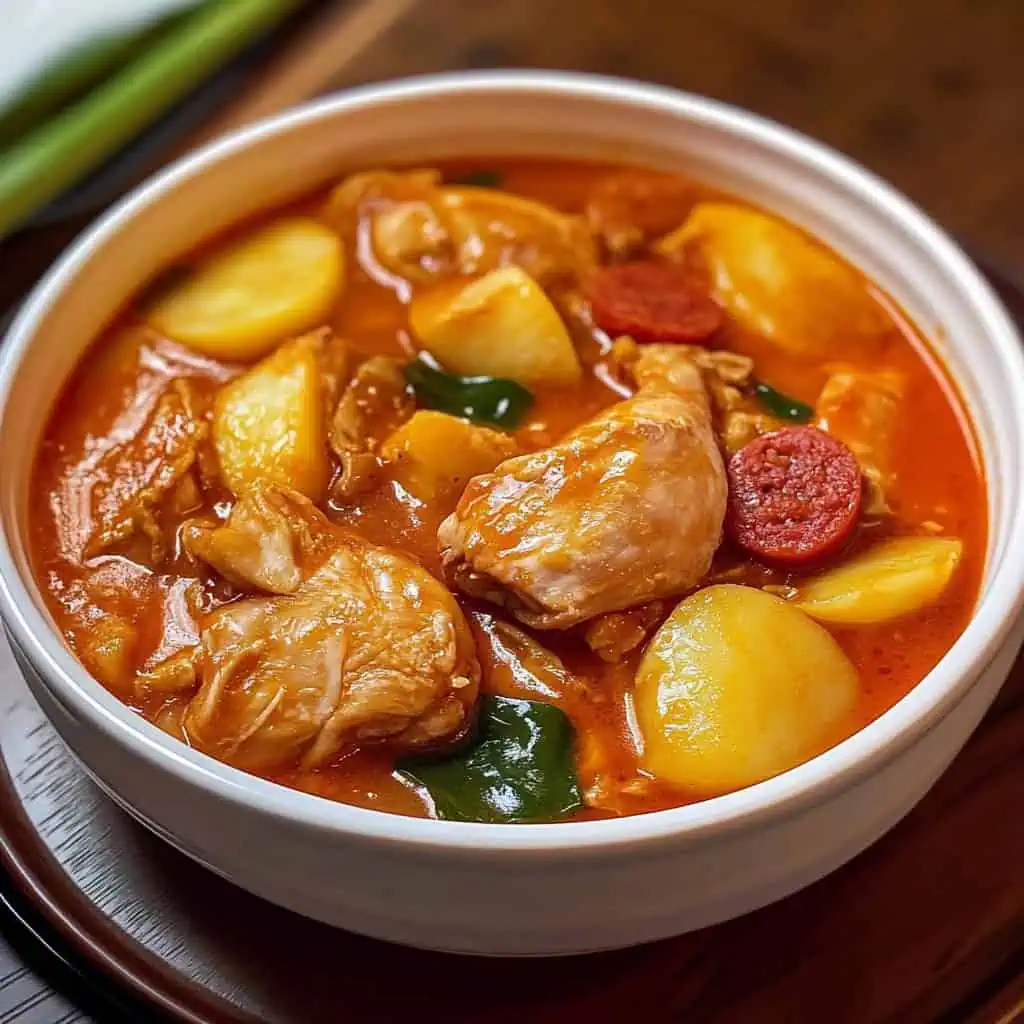

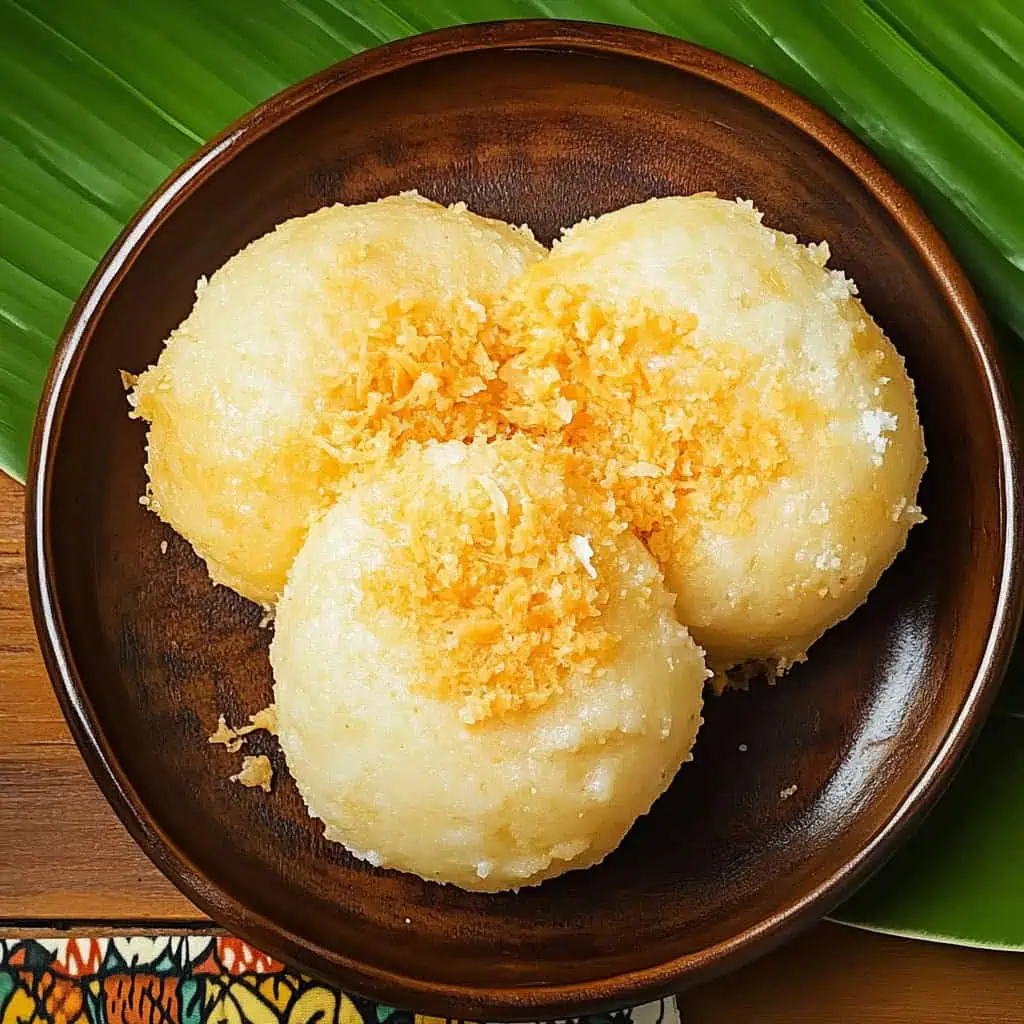
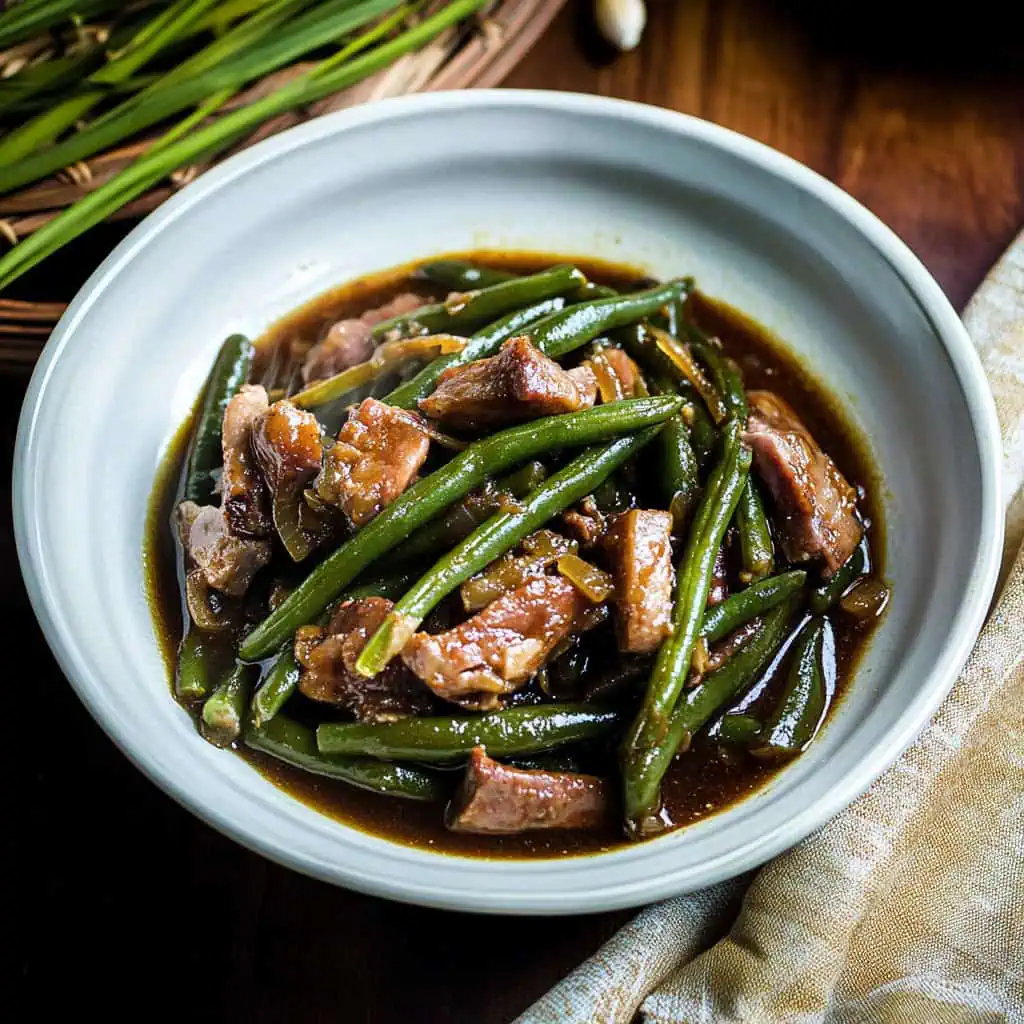
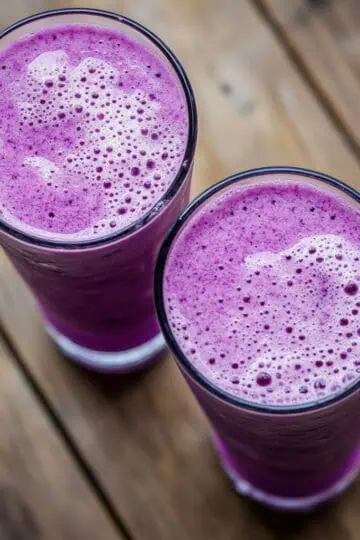
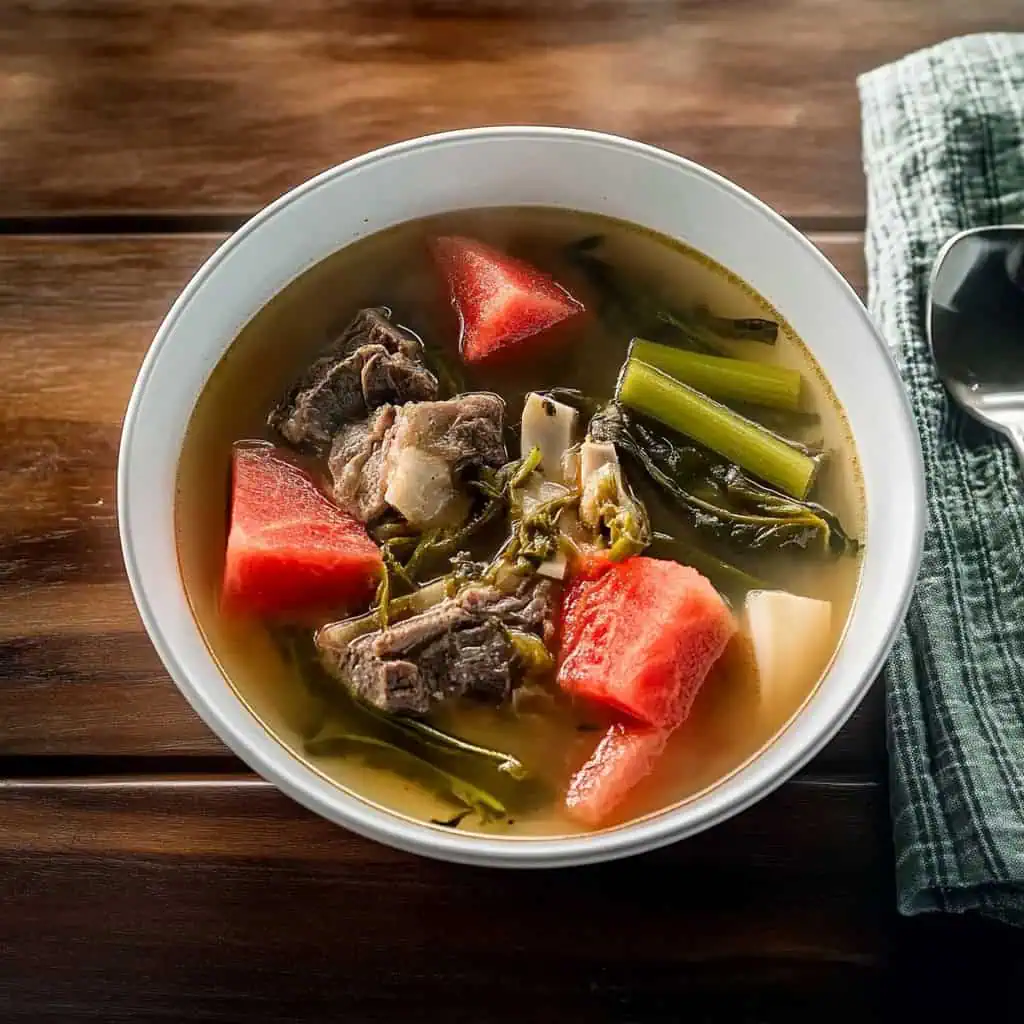




Comments
No Comments